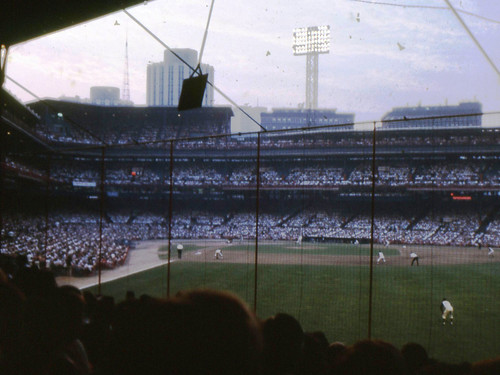Sunday, 3 April 2011
Old Ballparks and other Stadia
Recently it was noticed that the baseline at Yankees Stadium had been added as a oneway footway on OpenStreetMap. This triggered a discussion about the minutae of the game on #OSM. Now, much as I love baseball, I'm pretty hazy on the fine points of the rules, and, indeed, terminology. This is pretty much because all of my knowledge was garnered as a third-grader a very long time ago. I only ever saw two MLB games live (box scores here and here), both at the long vanished Forbes Field.
This prompted another rumination about the geography of vanished bits of the social fabric (which seems to be a developing theme on this blog).
In Britain and the States a huge number of sports stadia were built at the start of the 20th century. When I was growing up these places had a suitable romantic patina from age and great sporting exploits: a romance which belied their often smelly reality (John Bishop is very good on this). By the 1960s even with a modest amount of investment they were becoming rapidly superseded by social change. Many were difficult to maintain, were no longer suitably located (particularly when fans started coming by car) or had more profitable uses.
Cheaper air transport drastically affected Major League Baseball: it was no longer necessary that all the MLB franchises be within an overnight train journey of each other (discussed and mapped in "Spatial organization; the geographer's view of the world" (Abler, Adams and Gould (1971) pp. 377-9). So in the late '50s the Boston Braves moved to Milwaukee, the Brooklyn Dodgers to Los Angeles and the New York Giants to San Francisco. Although franchises had moved a bit before that time, it ushered in an era where owners could extort subsidies from local tax payers by threatening to move the club. Yet in many ways the more modern stadia were a false start. The multi-purpose stadia built in this period ('cookie-cutters') have now being torn down and replaced by separate parks for baseball and gridiron. That great novelty, an indoor ballpark, the Houston Astrodome is now a mouldering, crumbling safety hazard. Perversely more recent ball parks have tried to capture the feel of the early 20th century Jewel box parks.
In Britain change came later, and in response to several fatal disasters which highlighted the poor safety arrangements of many of the older grounds. As a teenager I watched games from cinder-covered terraces, or seated in wooden fire traps like that of the Bradford fire. Notts County's 1910 Meadow Lane ground even had a stand which was older than the ground, having been transported across the Trent from the county cricket ground.
These are the English Football League grounds which have vanished since I watched a match there : Filbert Street (Leicester), the Baseball Ground (Derby), Saltergate (Chesterfield), The Old Showground (Scunthorpe), Fellows Park (Walsall). I'm not particularly nostalgic for any of these, as a kid it was often difficult to get a decent view, the loos were laughable, and as we learnt, safety was poor. Filbert Street was a disaster waiting to happen: we 'watched' a game in such a crush that my father was so fearful of our safety that he hoisted us to the top of a wall away from the crowd. Variously these are supermarkets, housing developments or still brownfield.
However, the memory of great sporting drama at such vanished locations lives on in the memories of thousands of people. Over the past few years, The Observer has run a fascinating series of articles on the fate of a whole range of stadia after they ceased use for sport. These often managed to illustrate the intricate relationship between sport, economics and (urban) social fabric. Unfortunately these pieces don't seem to be available on-line. There are plenty of websites devoted to the subject: e.g., Old Grounds, and Aerial Lost Stadiums. Wikipedia's articles on the subject are usually detailed and thorough.
Stadia like many other historical sites are problematic to map on OpenStreetMap. When some fabric remains, then it's usually possible to tag this in such a way so as to indicate its original purpose. Adding single nodes for the former site (as the imported GNIS node does for Forbes Field) is probably acceptable, without challenging OSM's absence of a model for historical mapping. Culturally, the sites of old stadia might elicit wider interest, than, say, sites of battlefields.
Subscribe to:
Post Comments (Atom)

No comments:
Post a Comment
Sorry, as Google seem unable to filter obvious spam I now have to moderate comments. Please be patient.